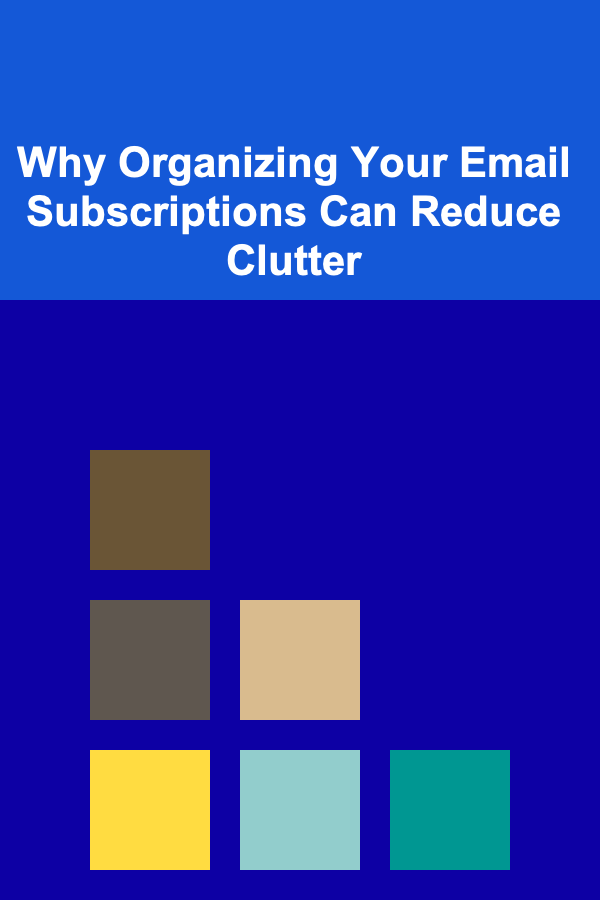
Why Organizing Your Email Subscriptions Can Reduce Clutter
ebook include PDF & Audio bundle (Micro Guide)
$12.99$8.99
Limited Time Offer! Order within the next:

In today's digital age, email remains a primary mode of communication for both personal and professional interactions. However, with the increase in online shopping, newsletters, promotional offers, and other subscriptions, our inboxes can quickly become overwhelming. The clutter created by unorganized email subscriptions not only affects our productivity but also impacts our mental well-being. This comprehensive guide will delve into the importance of organizing your email subscriptions, exploring practical strategies for decluttering your inbox and maintaining an organized email system over time.
The Importance of Organizing Email Subscriptions
1. Reducing Inbox Overwhelm
One of the most immediate benefits of organizing your email subscriptions is the reduction of inbox overwhelm. An overflowing inbox can be stressful, making it difficult to locate essential emails amid promotional messages or irrelevant content. By organizing your subscriptions, you create a clearer, more manageable environment conducive to productivity.
2. Enhancing Productivity
Unorganized emails can lead to distractions that disrupt workflow. When important emails are buried under promotional offers, it becomes challenging to focus on significant tasks. By decluttering your subscriptions, you streamline communication, allowing for greater efficiency and increased productivity.
3. Improving Mental Clarity
A cluttered inbox can contribute to feelings of anxiety or stress. Just as physical clutter can negatively affect mental space, so too can digital clutter. Organizing your email subscriptions alleviates this burden, promoting a sense of calm and clarity, enabling you to approach tasks with a clearer mindset.
4. Ensuring Important Communications Are Not Missed
When subscriptions fill your inbox, there's a higher likelihood that critical emails may go unnoticed or be incorrectly prioritized. An organized email system helps you ensure that you don't miss vital communications, whether they're work-related updates, family messages, or appointments.
5. Encouraging Mindful Consumption
Organizing your subscriptions fosters mindfulness regarding your online interactions. It encourages you to evaluate which subscriptions genuinely add value to your life and which ones simply clutter your inbox. This process promotes intentionality in your digital consumption habits.
Step-by-Step Guide to Organizing Your Email Subscriptions
Step 1: Assess Your Current Subscriptions
a. Take Inventory
The first step toward organizing your email subscriptions is to assess what you currently have. This involves going through your inbox and identifying all email subscriptions.
- Create a List: Document each subscription as you encounter it. Note the sender and the frequency of emails received (daily, weekly, monthly).
b. Identify Categories
Group your subscriptions into categories based on their purpose. Possible categories might include:
- Newsletters: Informational emails from publications or blogs.
- Promotions: Marketing emails from brands or stores.
- Notifications: Alerts from applications or services.
- Personal Correspondence: Emails from friends or family members.
Step 2: Evaluate Each Subscription
a. Prioritize Value
As you review your list of subscriptions, assess the value of each one. Ask yourself the following questions:
- Does this subscription provide valuable information?
- Am I genuinely interested in the content?
- How often do I engage with this subscription?
b. Consider Usage Frequency
Categorize your subscriptions based on how frequently you use them. Sorting subscriptions into "Essential," "Occasional," and "Rarely Used" can help prioritize which ones to keep and which to eliminate.
Step 3: Unsubscribe from Unwanted Emails
a. Use Unsubscribe Links
Most marketing emails contain an unsubscribe link at the bottom. Click these links to remove yourself from lists that no longer serve your interests.
b. Utilize Unsubscription Tools
For a more streamlined approach, consider using unsubscription tools like Unroll.me or Cleanfox. These services help you identify and unsubscribe from multiple email lists simultaneously.
c. Make Decisions Quickly
When evaluating subscriptions, make prompt decisions. If you find that a subscription no longer serves you, unsubscribe immediately to avoid second-guessing later.
Step 4: Organize Remaining Subscriptions
a. Create Folders or Labels
Implement a folder or labeling system within your email client. Popular email services like Gmail and Outlook allow users to create custom folders or labels to categorize emails.
- Examples of Folder Structures :
- Newsletters
- Promotions
- Work Communication
- Family/Friends
b. Use Filters to Automate Organization
Set up filters to automatically sort incoming emails into designated folders. For example, you can create a filter that routes promotional emails directly to a "Promotions" folder, keeping them out of your main inbox.
Step 5: Establish a Maintenance Routine
a. Schedule Regular Reviews
Organizing your email subscriptions is not a one-time task; it requires regular maintenance. Schedule periodic reviews---perhaps once every few months---to reassess your subscriptions.
b. Stay Mindful of New Subscriptions
Be discerning about new subscriptions. Before signing up for a new service or newsletter, ask yourself if it adds significant value to your life.
Step 6: Keep Up With Best Practices
a. Limit Sign-Ups
To prevent future clutter, limit the number of subscriptions you sign up for. Develop criteria for accepting new subscriptions, focusing on those that provide genuine interest or benefit.
b. Consider Temporary Subscriptions
If you're interested in a specific promotion or event, consider temporary subscriptions. Some email services allow you to unsubscribe easily after you've received necessary information.
c. Use Throwaway Emails for Trials
When signing up for trials or temporary offers, consider using a throwaway email address instead of your primary one. Services like TempMail can generate disposable email addresses, preventing unwanted spam.
Advanced Tips for Managing Email Clutter
1. Implement Email Management Apps
Explore email management applications that facilitate organization. Tools like Spark or Newton offer features such as snoozing emails, customizable folders, and integrated calendars, enhancing your email experience.
2. Practice the "Two-Minute Rule"
When processing emails, adopt the two-minute rule: if an email can be addressed in two minutes or less, handle it immediately rather than letting it linger in your inbox.
3. Archive Instead of Delete
If you're unsure about deleting an email, consider archiving it instead. Archiving removes it from your inbox while still keeping it accessible for future reference.
4. Leverage Search Functions
Make use of search functions within your email client to locate specific subscriptions or emails quickly. Familiarize yourself with advanced search options to streamline this process.
5. Use Shortcuts and Keyboard Commands
Learn keyboard shortcuts for your email client to navigate and manage your inbox more efficiently. Mastering shortcuts can significantly speed up email organization.
Overcoming Common Challenges
1. Emotional Attachment to Subscriptions
Challenge: You may find it challenging to let go of certain subscriptions due to emotional attachments or nostalgia.
Solution: Consider keeping a digital archive of cherished emails rather than retaining the entire subscription. Save memorable newsletters or important announcements in a dedicated folder.
2. The Temptation of Promotions
Challenge: The allure of promotions can lead to impulsive subscription choices.
Solution: Prioritize evaluating the long-term value of promotions before subscribing. Focus on benefits and engagement rather than immediate gratification.
3. Inconsistent Engagement Patterns
Challenge: You may find yourself fluctuating between periods of high engagement and times when you neglect subscriptions altogether.
Solution: Reassess your subscriptions during low-engagement periods. If certain subscriptions consistently go untouched, consider unsubscribing to reduce clutter.
4. Resistance to Change
Challenge: A reluctance to change established routines can impede efforts to organize your subscriptions.
Solution: Start small by setting manageable goals, such as cleaning out a single category of subscriptions each week. Gradually build momentum until the process feels more natural.
The Long-Term Benefits of Organizing Email Subscriptions
1. Enhanced Efficiency
An organized email system streamlines communication and reduces the time spent sifting through irrelevant messages. This efficiency extends to all aspects of your digital life.
2. Improved Focus
With fewer distractions in your inbox, you can concentrate on critical tasks without the constant interruptions caused by promotional emails or irrelevant notifications.
3. Better Time Management
Organizing your email subscriptions allows for better time management. You'll spend less time managing emails and more time engaging in meaningful activities.
4. Healthier Digital Habits
By establishing processes for managing email subscriptions, you cultivate healthier digital habits. This practice promotes mindfulness around technology use and encourages intentional engagement.
5. Reduced Stress
An organized inbox contributes to lower stress levels. As digital clutter diminishes, so does the cognitive load associated with managing excessive information.
Conclusion
Organizing your email subscriptions is a crucial step toward reducing clutter and improving overall productivity. By assessing your current subscriptions, prioritizing valuable communications, and implementing effective organizational strategies, you can create a streamlined email experience that supports your goals.
Remember, organization is an ongoing journey that requires periodic reevaluation and adaptation to changing needs. Embrace the process, stay mindful of your digital consumption, and enjoy the numerous benefits associated with a well-organized email system.
By taking control of your email subscriptions today, you set the stage for a more efficient, focused, and fulfilling digital life. Start small, stay consistent, and watch as your inbox transforms from cluttered chaos into a well-organized tool for success.
Reading More From Our Other Websites
- [Home Storage Solution 101] How to Declutter Your Living Room with Innovative Space-Saving Furniture Like Ottoman Storage and Wall-Mounted Shelves
- [Tiny Home Living Tip 101] Best Space‑Saving Kitchen Hacks for Tiny Home Living with Minimalist Aesthetics
- [Home Party Planning 101] How to Integrate Unique Balloon Decoration Ideas Beyond the Arch for Your Celebrations
- [Gardening 101] Pollinator‑Friendly Edible Gardens: Boosting Biodiversity While Growing Food
- [Personal Care Tips 101] How to Choose a Foundation That Won't Clog Pores
- [Organization Tip 101] How to Plan a Scenic Nature Walk or Hike for Families
- [Home Rental Property 101] How to Find Houses for Rent with a Fireplace for Cozy Winter Nights
- [Personal Care Tips 101] How to Use Cuticle Oil to Improve Nail Appearance
- [Home Soundproofing 101] How to Soundproof a Home for Sensitive Ears
- [Personal Investment 101] How to Make Money with AI Products Built on Deep Learning

How to Create a System for Managing Car Finances
Read More
How to Create an Office Supply Wishlist for Future Purchases
Read More
How to Create DIY Pet Toys and Enrichment Activities
Read More
How to Make the Most of Under-Bed Storage in Small Bedrooms
Read More
Why Organizing Your Home Can Boost Your Mental Health
Read More
How to Conserve Water for Wildlife Habitats
Read MoreOther Products

How to Create a System for Managing Car Finances
Read More
How to Create an Office Supply Wishlist for Future Purchases
Read More
How to Create DIY Pet Toys and Enrichment Activities
Read More
How to Make the Most of Under-Bed Storage in Small Bedrooms
Read More
Why Organizing Your Home Can Boost Your Mental Health
Read More